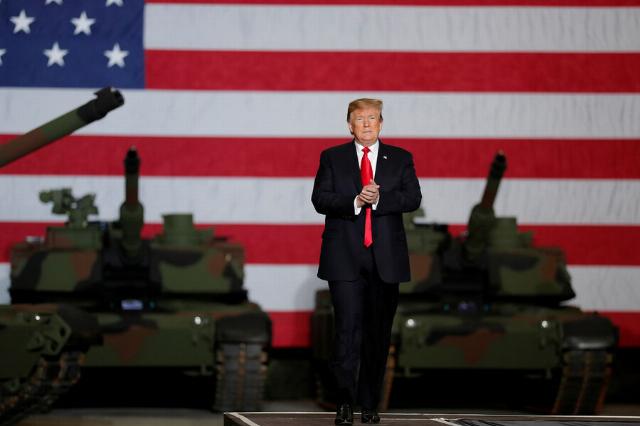Colonel Khodarenok: the US armed forces under Trump will take into account their experience
The inauguration of the 47th President of the United States, Donald Trump, will take place on January 20. In his speech, the new head of the White House will surely touch upon US national security issues. Military observer of "Gazeta.Mikhail Khodarenok tried to imagine what the "US global leadership" in the military sphere will be based on, what kind of weapons Washington will have and what Donald Trump's "nuclear cudgel" will look like.
At 12 p.m. (20.00 Moscow time) on January 20, President Donald Trump and Vice President Jay D. Vance will be sworn in. After taking the oath of office, the President of the United States will deliver an inaugural address outlining his foreign and domestic policy priorities for the next four years.
There is no doubt that in his speech, the head of the White House will address issues of US national security and the most important problems of building the US Armed Forces. However, in such speeches, the head of state usually does not dwell on any details and details of strengthening the country's military power.
Let's try to imagine what priorities in the field of construction and combat use of the US Armed Forces the attention of the head of the White House will be focused on in the coming four years. Most likely, at first, Donald Trump will act within the framework of the US defense budget for 2025 ($895 billion) and the National Defense Strategy (NDS), approved on October 27, 2022. At the same time, there is no doubt that very significant adjustments will be made to many of the fundamental documents related to the study of the experience of Russia's Special Military Operation.
Comprehensive deterrence of opponents
Strategic deterrence remains the top priority of the U.S. Department of Defense. In the foreseeable future, nuclear weapons, according to the Pentagon, will continue to have a unique deterrent effect that no other element of military power can replace. The Pentagon intends to modernize its strategic nuclear forces, production and support infrastructure, scientific and engineering base.
Most of the national nuclear deterrence systems of the United States were created in the 1980s and earlier. After multiple extensions, the service life of all systems currently in operation will expire in the mid-2030s.
The recapitalization of nuclear platforms, delivery systems and related support systems will require significant investments over the next 20 years, according to the US Department of Defense. The following table shows the financing of the six most important weapons systems.
close
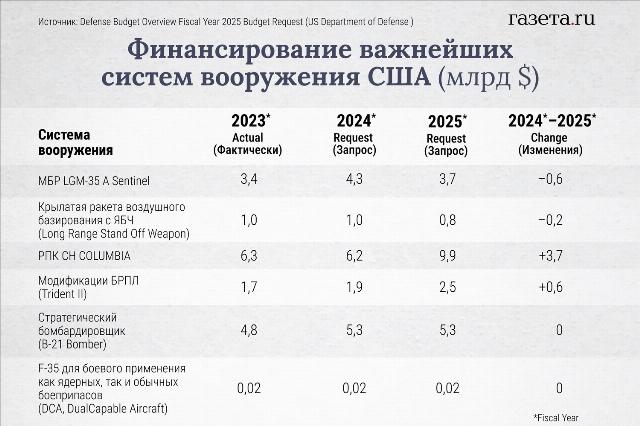 |
| Financing of US weapons systems. |
| Source: Alina Djus/"Newspaper.Ru" |
Let's take a closer look at some of the weapons listed in the table.
The LGM-35A Sentinel intercontinental ballistic missiles (formerly the Ground-Based Strategic Deterrent) will replace the Minuteman (MM) III intercontinental ballistic missiles developed in the 1970s.
The LGM-35A Sentinel ICBM, according to the developers, will retain the adaptive and stabilizing characteristics of the ground-based component of the nuclear triad, while providing enhanced capabilities, safety and reliability. The financing in the next defense budget reflects the continuation of Engineering and Manufacturing Development (EMD).
As for the Long Range Stand Off (LRSO) Weapon, an armament system will be developed within the framework of this project to replace the AGM-86B (ALCM) air-launched cruise missile, which entered service in 1982.
It is believed that the LRSO missile will be able to penetrate the enemy's advanced integrated air defense systems. The program is currently in the EMD phase and on its way to achieving initial operational readiness.
The COLUMBIA strategic missile submarine (PKK CH) is being developed to replace the Ohio-class PKK CH (OHIO) starting in October 2030. In September 2020, the full-scale construction of the first ship of this project (SSBN 826) started. In September 2023, it was decided that the construction of the second building (SSBN 827) should begin in fiscal year 2024. The $9.9 billion budget request for fiscal year 2025 reflects a $3.7 billion increase in financing, due to an increase in the production base and preliminary costs for the purchase of submarines for fiscal year 2026.
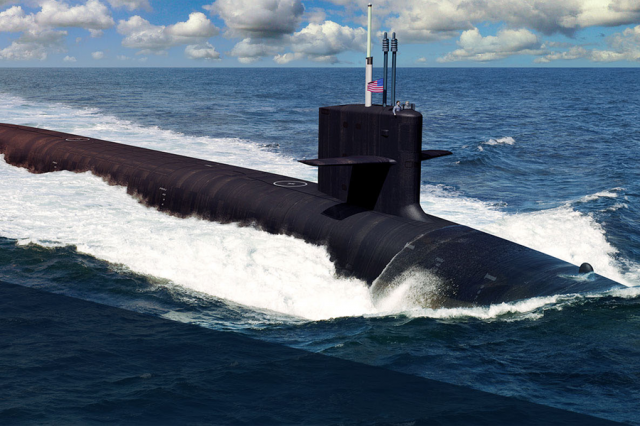 |
| US Navy SUBMARINES. |
| Source: U.S. Naval Sea Systems Command Image/Wikimedia |
Additional funds are planned to be allocated for Trident II (D5) extended-life submarine-launched ballistic missiles (D5LE/D5LE2 modifications). These missiles will remain in service with the US Strategic Nuclear Forces for the entire life of the OHIO-class submarines (until the early 2040s), that is, until the initial deployment of the COLUMBIA-class CH and DREADNAUGHT-class PKK in the United Kingdom is planned.
Serial production of the B-21 Raider strategic bombers began in fiscal year 2024. When they enter service, the US Department of Defense emphasizes, it will be an affordable long-range aircraft equipped with proven technologies. According to the Pentagon, this bomber represents a key component in the combined arsenal of means of delivering a deep strike against the enemy with conventional and nuclear weapons.
The F-35 fighter jet for combat use of both nuclear and conventional munitions (DCA, Dual Capable Aircraft) will replace obsolete 4th generation fighters, including the F-15E, and will be designed to fulfill the NATO nuclear deterrence mission. Individual F-35A fighters of the United States and its allies in the European Theater of Operations received operational nuclear certification at the beginning of fiscal year 2024.
This is how the nuclear cudgel of the 47th President of the United States, Donald Trump, will look like.
Air superiority
The efforts of the US military-industrial complex in the field of the Air Force are still largely focused on the implementation of the Next Generation Air Dominance Program (NGAD, "New Generation Air Superiority"). It involves the deployment of an entire family of connected systems for conducting combat operations in airspace, which may include fighter jets, unmanned aerial vehicles, satellites in space, and platforms in cyberspace. But this is not some isolated super destroyer. By and large, the aircraft in the promising developments of the United States ceases to be a backbone element. In this regard, NGAD is sometimes referred to as a "system of systems"
At this stage, the main investments in tactical aviation in the fiscal year 2025 budget request are the F-35 Lightning II Joint Strike Fighter jets, which will become the backbone of the US Air Force's air power.
As part of the F-35 program, three variants of the 5th generation strike fighter are being developed, manufactured and put into service.: 1) The F-35A Conventional Takeoff and Landing (CTOL) option for the Air Force, 2) the F-35B short takeoff and vertical landing option for the Marine Corps (STOVL), and 3) the F-35C (CV) option for the Navy.
The F-35's stealth, advanced sensors and interoperability ensure uninterrupted information exchange, which makes this fighter in combat conditions, according to the Pentagon, "smarter, deadlier and more resilient."
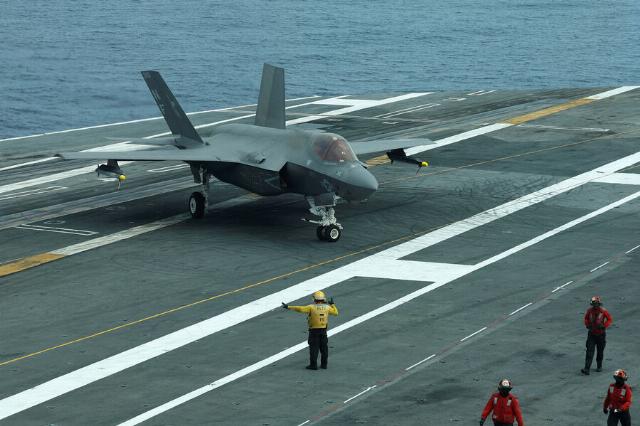 |
| The F-35 fighter jet. |
| Source: Kim Kyung-Hoon/Reuters |
The budget for fiscal year 2025 also provides for the purchase of additional F-15 EX Eagle II aircraft.
Financing continues for the US Navy's MQ-25 Stingray unmanned aerial system, which will provide the US Department of Defense with an unmanned tanker tanker, which will increase the strike power of the aircraft carrier's wing and at the same time provide sea surveillance for the aircraft carrier strike group.
The budget for fiscal year 2025 also provides for the purchase of a KC-46A tanker aircraft, which will replace obsolete tankers. The KC-46A provides enhanced refueling capabilities for U.S. Navy and Air Force aircraft.
The budget for fiscal year 2025 provides for financing the Air Force's efforts to replace the aging fleet of AWACS and U (long-range radar detection and control) E-3 Sentry aircraft with the E-7 Wedgetail version.
Financing of various electronic warfare systems is also provided for this period. In addition to the current modifications of the EA-18G Growler electronic warfare aircraft, the Next Generation jamming device (NGJ) It will provide significantly improved electronic warfare (Airborne Electronic Attack, AEA) capabilities against advanced integrated air defense radars, communications and data links for EA-18G aircraft.
The budget for fiscal year 2025 also provides funds to increase the survivability of the passive-active warning and survivability enhancement system of the F-15 Eagle (EPAWSS) and the integrated electronic countermeasures system for F/A-18 aircraft.
In addition, funds are provided for the continued production of the Common Infrared Countermeasures (CIRCM) system to combat current and emerging missile threats to helicopters, tiltrotor planes and small fixed-wing aircraft.
In total, $61.2 billion is expected to be allocated to the US Air Force in 2025.
Supremacy on earth
The Pentagon plans to make a final decision over the next two years on the future appearance and organizational structure of the formations of the US Army forces of the 2040 model.
During this period, the US military plans to find out what the cardinal differences of the battlefields of the future will be and what the overall operating environment will look like in the foreseeable future. Undoubtedly, these studies will be greatly influenced by the experience of combat operations gained during the armed conflict in Ukraine.
The Convergence Ground Forces Project, a large-scale campaign to improve the capabilities of the US armed forces, which was launched in 2020, is one of the platforms for such experiments.
Prospective formations of the US Army should have appropriate integration, a kind of hybrid of man and machine, which can significantly change the rules of the game on the battlefield. For example, it is supposed to replace a tank with a robot tank. It is planned to transfer a significant part of the rough soldier's work and even more risky tasks to machines and mechanisms instead of fighters.
The budget of 2025 provides for the allocation of $ 13 billion for the modernization of weapons and military equipment of the US Army and Marine Corps, including armored multipurpose vehicles, amphibious combat vehicle and infantry fighting vehicle XM30.
The XM30 promises to be a real breakthrough in the field of armored vehicles and is a contender to replace the famous M2 Bradley infantry fighting vehicle. The basis of the new XM30 combat vehicle is the German Lynx KF41 infantry fighting vehicle, which needs to be adapted to the requirements of the Pentagon. Experts promise to provide the new armored vehicle with an open architecture with the ability to integrate various systems.
 |
| Lynx. |
| Source: Alina Djus/"Newspaper.Ru" |
Domination of the seas and oceans
The budget request for fiscal year 2025 provides for the allocation of $48.1 billion for investments in the state's maritime power with the construction of six ships for the US Navy, including one Virginia-class multipurpose nuclear submarine, two DDG 51 Flight III modified Arleigh Burke-class destroyers with an upgraded air defense radar./AN/SPY-6(V) missile defense system, one Constellation-class guided missile frigate, one LPD-17 San Antonio-class amphibious assault ship, and one Medium Landing Ship.
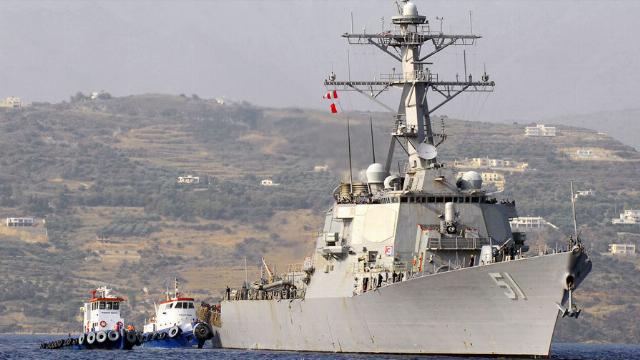 |
| The destroyer Arleigh Burke. |
| Source: Mr. Paul Farley/U.S. Navy |
The Pentagon remains convinced that nuclear aircraft carriers (CVN) They provide an "advanced air force projection presence."
The budget for fiscal year 2025 provides additional financing for the construction of new Gerald R. Ford-class nuclear aircraft carriers: John F. Ford Kennedy (CVN 79), the transfer of the ship to the Navy is planned in 2025, Enterprise (CVN 80), due to enter service in 2028, and Doris Miller (CVN 81).
CVN 81 is scheduled to be laid in January 2026, launched in October 2029, and commissioned in 2032. CVN-81 will be the first aircraft carrier named simultaneously after an ordinary sailor and an African-American who distinguished himself during World War II.
The foundation of all American politicians
Very large funds ($143.2 billion) are expected to be allocated for research, development, testing and evaluation (Research, Development, Test and Evaluation, RDT&E). This concerns investments in responsible artificial intelligence, 5G, and various kinds of experiments. $17.2 billion is expected to be allocated to science and technology, including investments in basic research worth $2.5 billion.
It is precisely such actions, according to the Pentagon, that will allow the US Armed Forces to provide sustainable advantages in conducting military operations. As for the possible decisions of the new US President, Donald Trump, it is unlikely that he will decide on any drastic revision of previously approved programs and funding in the near future.
But it is safe to say that Donald Trump will not revise the statement of US Secretary of Defense Lloyd J. Smith. Austin at the Reagan National Defense Forum in December 2023: "Only one country on Earth can provide the leadership that this moment requires. And only one country can consistently provide a powerful combination of innovation, ingenuity, and idealism, as well as free minds, free enterprise, and free people. And this is the United States of America." This statement is at the forefront of the actions of all American politicians.
The opinion of the author may not coincide with the position of the editorial board.
Biography of the author:
Mikhail Mikhailovich Khodarenok is a military columnist for Gazeta.Ru", retired colonel.
He graduated from the Minsk Higher Engineering Anti-Aircraft Missile School (1976), the Military Air Defense Command Academy (1986).
Commander of the S-75 anti-aircraft missile division (1980-1983).
Deputy commander of the anti-aircraft missile regiment (1986-1988).
Senior Officer of the General Staff of the Air Defense Forces (1988-1992).
Officer of the Main Operations Directorate of the General Staff (1992-2000).
Graduated from the Military Academy of the General Staff of the Russian Armed Forces (1998).
Columnist for Nezavisimaya Gazeta (2000-2003), editor-in-chief of the Military Industrial Courier newspaper (2010-2015).
Mikhail Khodarenok
